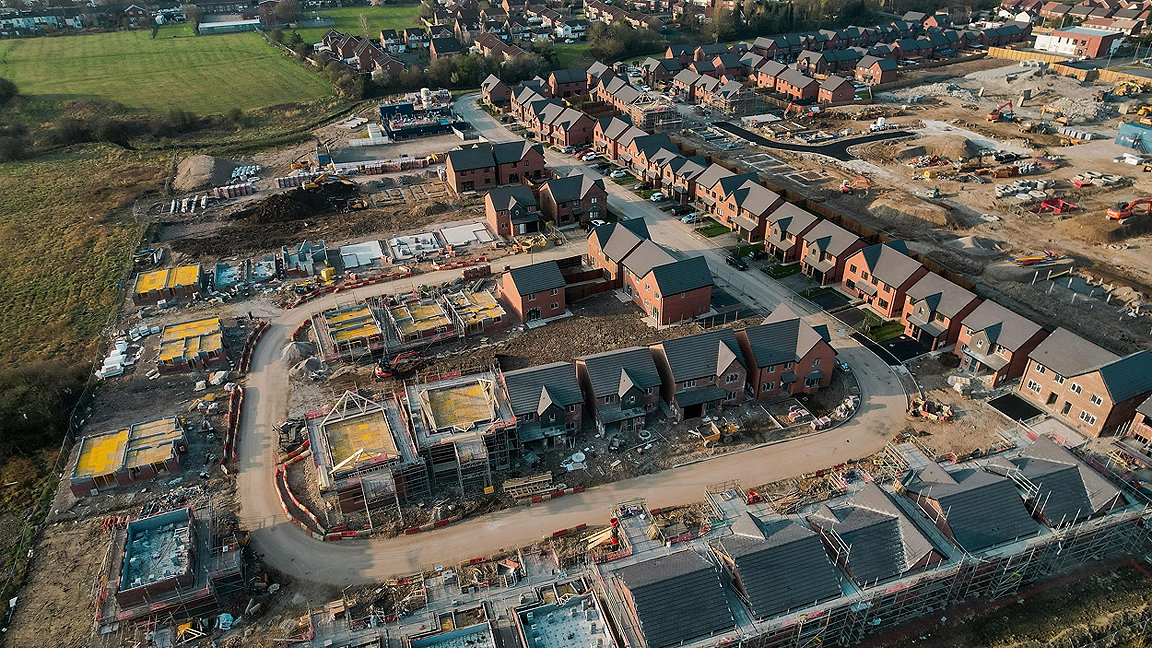
Since 2020, the UK's construction industry has experienced shocks ranging from Brexit to multiple wars, all having a varied but significant effect on the cost of materials and labour. The COVID-19 pandemic, however, made the greatest impact.
The global pause in construction activity due to national lockdowns was relatively short and sharp. However, because construction material manufacturers ran at reduced capacity the supply to the market was limited, which stressed a key vulnerability of just-in-time production processes.
The reduced supply, coupled with a sizeable increase in demand after lockdown as sites reopened, led to a sharp rise in prices across practically all materials. Timber and steel in particular rose by 79% and 77% respectively between the first and third quarter of 2021.
Continued hyperinflation is further evidenced by data from the Construction Materials Price Index (see Figure 1); 2022 and 2023 saw overall material price inflation rise above 15% a year, compared with single-figure historical fluctuations.
Figure 1: Analysis of Construction Materials Price Index 2011–23. Source: Ibis World
Historical data suggests that, under normal conditions, an increase of 15–20% in inflation can take up to a decade to occur cumulatively. Therefore, these figures represent almost unprecedented shifts in price points.
What we saw in 2022 and 2023 in terms of price deviation year on year was therefore staggering; and is perhaps the key reason why, by August 2023, 4,263 UK construction firms had gone out of business since the start of the year. This figure is 8.3% higher than in 2022 and 34.5% higher than in the year to January 2020.
Construction market hit by housing slowdown
Demand in the housing market and private housebuilding sector fell sharply at the end of 2022 following the mini-budget of Liz Truss and Kwasi Kwarteng, and this meant that the run-in to 2023 was not positive.
Private housing output at the end of 2023 was around 20% lower than that of 2022, and with this being the most significant construction subsector – worth £40.8bn annually – the impact in the broader industry is considerable.
Despite these poor numbers, there is better news. More than a year after peaks in energy, oil and commodity prices in summer 2022, inflation in the UK economy slowed in 2023.
This is not the end of the story, however, because inflation will probably be stubborn throughout 2024 and into 2025, particularly after recent oil price uncertainty.
Interest rates are likely to remain at a peak for longer than previously expected, and, therefore, this is likely to lead to a slower recovery in the housing market.
At the time of writing, the Construction Products Association has forecast that construction output for 2023 will fall by 6.8% compared with 2022. Growth in 2024 is set to recede further, albeit dropping by only 0.3%.
Competition for labour increases costs
As a result, many in the construction industry are asking what this will likely mean for tender prices, as well as the cost of materials and labour.
The labour market is shrinking at an astonishing pace, and the current rate of retirement is higher than that of hiring.
The largest demographic employed in construction is the over-60s, who are starting to retire, while the under-30s are the fastest decreasing demographic. As a result, the sector as a whole needs to recruit 45,000 people annually for the next five years just to maintain current output levels.
At the same time, Build UK's People Survey Report – May 2023 reported that 56% of respondents expected to increase their respective companies' direct employment levels over the subsequent 12 months, suggesting demand is far greater.
Alongside this, the National Federation of Builders conducted a survey of contractors in February 2023 for the Construction Leadership Council.
They found that 84% of respondents said their business had experienced a labour shortage for more than a year. Some of the most frequently mentioned shortages included carpenters, at 46%, bricklayers, at 35%, and plasterers and dry liners, at 17%.
Since then, the government has added bricklayers, roofers, carpenters and joiners to the shortage occupation list to encourage migration.
Reduced labour supply is leading to higher demand and increased costs. BCIS reported in August 2023 that construction site wages increased by almost 5% in the second quarter of 2023, compared with data from the third quarter of 2022.
Moreover, against the first quarter of 2023, average site wages were up 4.2% by August. The trend is that the skill shortage leads to competition for labour and increases wages.
As a result, BCIS chief economist Dr David Crosthwaite reported that annual growth in the BCIS labour cost index is predicted to rise to 8.3% in the second quarter of 2024.
In 2023, BCIS forecast that the five years from 2023 to 2028 will see tender prices across the industry rise by 17%, and in the years 2024 and 2025 costs will outweigh main contractor tender prices.
BCIS identified another interesting trend in employment based on data published by the Office for National Statistics (ONS) in summer 2023.
They reported that between April and June last year, the number of people employed by construction firms decreased by 0.7% while the number of self-employed people in the industry increased by 5.1%.
This suggests that labour employed on short-term contracts for immediate fulfilment has been able to take advantage of the skills shortage in the industry by demanding higher rates, encouraging a move into self-employment.
Materials price rises now levelling out
The cost of UK construction materials in 2022 rose by 15% compared to growth of 24.5% in 2021. To contextualise this, construction costs typically increase by 3–5% per year and in 2019, they dropped by 1%.
The Department for Business and Trade's latest Material Price Index dataset, published in January, exemplifies just how dramatic the shift has been, as is illustrated in Figure 2.
Figure 2: UK Material Price Index. Source: Department for Business and Trade
As the data shows, the index has gone through significant inflation since late 2020 but now appears to have plateaued.
There is little expectation that there will be another period of mass inflation; but neither are we expecting a return to pre-pandemic levels. These material prices appear to now be locked in.
Since the pandemic, timber for example has been an excellent benchmark for evaluating the current state of inflation in construction materials. A review of Trading Economics' lumber future index supports the thesis that:
- we are now in a plateau period after sustained inflation
- the cost of construction materials – in this case raw timber, or lumber – has levelled out significantly higher than it was before the pandemic.
Each material is subject to unique market forces. For example, the cost of steel was affected by the war in Ukraine.
One Ukrainian mill alone supplied more than 1.5m tonnes to the European market every year before the war, and the closure of that site led to supply shortages and had a short-term impact on the market price.
Despite this impact, steel as a commodity has now settled into an expected price range of 3,500–4,000 yuan per tonne, after considerable fluctuation between 2019 and 2021.
As is clear, the pandemic and its impact on supply and demand following lockdown also had a significant short-term effect on the cost of construction materials, mainly through 2021 and 2022, with a much more settled 2023.
Whatever the politics, inflation situation prompts hope
The UK is expected to have a general election in 2024, with the summer or autumn mooted as the most likely dates.
The prospect of an election may have a positive impact on construction, if the current government decides – for example – to announce stimuli for the UK economy in general and even construction specifically. But it could equally well lead to delays in policy decisions and public spending.
Therefore, it is hard to forecast the potential outcomes for the economy generally, and construction industry in particular. But clearly there will be an impact, and this should be closely monitored.
Taking a step back, though, if inflation continues to temper as it did last year, 2024 will likely see the UK's macroeconomic situation improve.
If this trend persists and inflation rates keep improving, this will likely lead to the Bank of England reducing interest rates, making mortgages more attainable.
Given the causal link between the number of mortgage applications and the private housing subsector of construction, there is hope that output will slowly and steadily improve. BCIS' construction industry forecast predicts that there will be no growth in 2024 as the UK economy continues to recover, but that 2025 and beyond will return to positive output.
We are not totally out of the woods; but no further hyperinflation in material prices is foreseen, provided there are no further external shocks.
The BCIS forecast, published in September, highlights that inflation in the All-In Tender Prices index is likely to grow in the five years running 2024 to 2028, but that this will be much more tempered as the index returns to a typical level.
While we are moving away from historical risks such as material supply and inflation, what should be front and centre among considerations for all diligent construction companies is the labour shortage.
There is hope that the government's recent additions to the shortage occupation list will see more skilled migration and reduce the burden. But the industry needs to face the challenge, as do contractors.
Indeed, it is for this reason that we at c-link have developed a sustainable tender strategy ebook, to encourage a change in main contractor mentalities that will support subcontractors.
In the meantime, we have yet to feel the full impact of the labour shortage because of the significant drop in construction output in 2022 and 2023.
As the industry rebounds and workloads increase between 2024 and 2028, this shortage will be more keenly felt.

